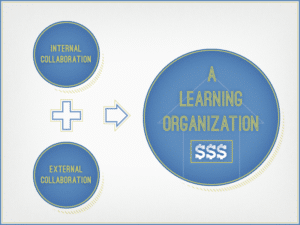(Editor’s Note: Today’s post is sponsored by SilkRoad technology, a leading provider of cloud-based social talent management solutions. SilkRoad recently announced the introduction of Point, an employee-centric social collaboration tool giving employees the forum they need to share internal expertise while helping the company achieve their business goals.)
According to the 2012 IBM CEO Study, the number one trait that CEOs are looking for in employees is collaboration. In fact, 75% of CEOs surveyed called it a “critical” skill. Can you guess why CEOs are so focused on collaboration? Yep, because it means money.
McKinsey research is labeling companies who are adopting highly collaborative workplace environments the “networked enterprise”. This new class of organization achieves its goals by using technology to its fullest extent. They use technology not just to connect with customers, partners and suppliers but to connect with each other internally.
Companies that are levering technology to the max are seeing higher profit margins and gaining market share. You can read the specifics in the McKinsey report here.
Basically what we are seeing is a digital divide: companies that adopt technology and realize the benefits of doing so versus those who don’t (and aren’t seeing the gains in profitability and market share).
Now you might be saying, “Hey – our company has a Twitter account and a Facebook page! We’re out there connecting with customers. We have XX Likes and XX Followers.” And that’s good. But it’s not the whole story. The companies that are achieving real results have integrated technology both internally and externally. The research suggests that the catalyst lies in the successful creation of internal collaboration networks. If organizations only focus their efforts on external collaboration, there’s a limit to how far their efforts will pay off. Think of it this way:
Internal collaboration + External Collaboration = Fully Networked Organization
Internal and external collaborations are not mutually exclusive, they are synergistic. They both must exist in order to achieve the full benefit. It kinda reminds me of the duality in Herzberg’s Motivation-Hygiene Theory.
Let’s focus for a moment on creating the internally collaborative organization. The logic here is, companies that collaborate successfully are more likely to give employees the tools to get stuff done (GSD). They are less bogged down by structure, policy and procedure. Organizations of this type tend to be more agile and responsive to customers. This creates an atmosphere of efficiency and speed…which translates into greater profits.
The externally collaborative organization is connected to the customer and to the marketplace. They know what people want. They communicate with suppliers and customers regularly.
Now combine those two thoughts into that networked enterprise. When you have an organization that knows what people want and delivers it quickly and efficiently, it’s a recipe for success. You can also look at it in the reverse to see why internal and external collaboration are so important.
If a company knows what customers want, but is so burdened with bureaucracy that they can’t deliver it. Hmmm…that’s not gonna work.
And if a business is very efficient in delivery systems, but there’s a big disconnect with the customer. Well, that’s not gonna work either.
Being able to connect both internally and externally opens the door for the organization to become what Peter Senge calls “a learning organization”, where the company can continuously learn from itself. The key to success is for companies to leverage their fully networked structure and create a learning organization. The model looks something like this.
For organizations to realize greater benefits, they must sit on the right side of the digital divide. There are 3 things they can do.
- Break down and/or eliminate obstacles to change,
- Smartly use technology for customer and business partner satisfaction, and most important…
- Integrate collaborative technologies into employees’ daily work.
There are days the message sounds like a broken record: sharing information and expertise makes our companies stronger and more successful. The good news is more organizations are starting to see the direct quantitative results of their efforts. As these results become mainstream, only one question remains…which side of the digital divide do you want to be on?








Stephen Ross says
The IBM study is simply quantitative research that illustrates an already well known fact: change with technology or perish. Computers and software have allowed companies unprecedented flexibility and communication internally and externally, and it is now the job of companies to meet this challenge or bear the consequences. Working in the HRIS industry has shown me that software can not only reduce the burden of the HR department, but also management and employees by providing a framework for sharing ideas and facilitating the completion of tasks.
However, there is a negative side to integration of software. As the workplace becomes more mechanized, it’s important not to lose the personal “human touch” that has been the cornerstone of customer service and employee collaboration for many years. Software may allow for enhanced sharing, but it walks a fine line with taking the humanity out of the workplace.
Ginger says
Great point, Stephen! It really is vital to keep in mind the importance of true human contact in the workplace. Companies should keep in mind the importance of a balance of technology and traditional communication. It’s something that will be different for everyone but with factors such as virtual workforces, which are growing larger and larger every day, these technologies certainly do come in handy.
Rodolph says
The formula for the company’s success is very true. I believe that internal collaboration should be as important as external collaboration because this gives the employees some form of culture and morale within the organization thus intensifying their sense of camaraderie and loyalty which in turn will benefit the company as a whole. What destroys collaboration? I think this is also a good topic to tackle.
-Rodolph
Courtney Hunt says
Thanks for sharing this pieces with the Social Media in Organizations (SMinOrgs) Community, Sharlyn. An interesting complement to your ideas is provided by the recent Social Media Garden research results published by Silverman Research. Here’s a post with a high-level summary and a link to the free report on SlideShare:
http://www.sminorgs.net/2012/07/4-big-barriers-to-social-media-adoption-in-organizations-key-research-findings-.html
Cory says
Great post, Sharlyn! I could have not written this any better myself.
Sharlyn Lauby says
Thanks everyone for the comments! I really appreciate it.
@Courtney – Thanks for sharing. I’m a big fan of what you’ve accomplished with SMinOrgs.
@Rodolph – You’ve asked a great question – What undermines collaboration? I’ll have to noodle that one for a while.